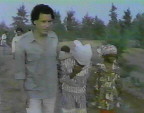QADHAFI OPENS SECOND PHASE OF GMMR PROJECT
1 September 1996
As part of the celebrations marking the 27th anniversary of Libya's
September First Revolution, Colonel Mu`ammar al-Qadhafi inaugurated the
second phase of the Great Man-Made River project. Speaking in Garboula to
an audience that included Libyans and foreign guests, Qadhafi stated "This
is the biggest answer to America and all the evil forces who accuse us of
being concerned with terrorism. We are only concerned with peace and
progress. America is against life and progress; it pushes the world
towards darkness."
Qadhafi and foreign dignitaries simultaneously pushed buttons which
caused a barrier to open, allowing water to gush forth into a catchment area.
Louis Farrakhan, leader of the U.S.-based Nation of Islam, who was one of
those taking part in the ceremony, described the Great Man-Made River as
"another miracle in the desert."
The newly-inaugurated stage of the project will provide Tripoli and
the surrounding region with fresh water pumped from sub-Saharan aquifers
and transported over hundreds of kilometers through vast networks of pre-
stressed concrete pipelines. Because a mountainous formation known as
"Jabal Nefussa" blocks the natural flow of the piped water from the areas
where the aquifers are located to the coastal plain, it was necessary to
drill a tunnel through the mountain and install a pumping station. It is
this tunnel, located at Tarhunah, that U.S. Secretary of Defense William
Perry earlier this year threatened to attack with nuclear weapons on the
pretext that it was a chemical weapons factory.
Perry has not been available for comment following yesterday's
inauguration of the water-pumping facility.
The Great Man-Made River is the largest water transport project ever undertaken,
Although Libya at present is more than 95% desert, during the time
of Christ the northern part of the country was a flourishing agricultural
region. The ruins of ancient cities such as Leptis Magna and Sabratha,
which today lie half-buried in the sand, are silent witnesses to this
bygone era. The goal of the Libyan people, embodied in the Great Man-Made
River project, is to restore the productivity of these formerly fertile
lands and to make Libya once again a source of agricultural abundance,
capable of producing adequate food and water to supply its own needs and
to share with neighboring countries.
and has been described as the "eighth wonder of the world".
Under construction since 1984, it will when completed carry more than five
million cubic meters of water per day across the desert to coastal areas,
vastly increasing the amount of arable land. The total cost of the huge
project is expected to exceed $25 billion(US).

Great Man-Made River Page Libya Links Page